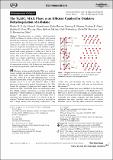Files in this item
The Ti3AlC2 MAX-phase as an efficient catalyst for oxidative dehydrogenation of n-butane
Item metadata
| dc.contributor.author | Ng, Wesley H. K. | |
| dc.contributor.author | Gnanakumar, Edwin S. | |
| dc.contributor.author | Batyrev, Erdni | |
| dc.contributor.author | Sharma, Sandeep K. | |
| dc.contributor.author | Pujari, Pradeep K. | |
| dc.contributor.author | Greer, Heather F. | |
| dc.contributor.author | Zhou, Wuzong | |
| dc.contributor.author | Sakidja, Ridwan | |
| dc.contributor.author | Rothenberg, Gadi | |
| dc.contributor.author | Barsoum, Michel W. | |
| dc.contributor.author | Shiju, N. Raveendran | |
| dc.date.accessioned | 2018-01-18T13:30:05Z | |
| dc.date.available | 2018-01-18T13:30:05Z | |
| dc.date.issued | 2018-02-05 | |
| dc.identifier | 251301005 | |
| dc.identifier | 681e1957-aa0a-4b7b-bd7f-196797735dcd | |
| dc.identifier | 85040176511 | |
| dc.identifier | 000423494500006 | |
| dc.identifier.citation | Ng , W H K , Gnanakumar , E S , Batyrev , E , Sharma , S K , Pujari , P K , Greer , H F , Zhou , W , Sakidja , R , Rothenberg , G , Barsoum , M W & Shiju , N R 2018 , ' The Ti 3 AlC 2 MAX-phase as an efficient catalyst for oxidative dehydrogenation of n-butane ' , Angewandte Chemie International Edition , vol. 57 , no. 6 , pp. 1485-1490 . https://doi.org/10.1002/anie.201702196 | en |
| dc.identifier.issn | 1433-7851 | |
| dc.identifier.other | ORCID: /0000-0001-9752-7076/work/58055056 | |
| dc.identifier.uri | https://hdl.handle.net/10023/12508 | |
| dc.description | H. F. G. and W.Z. thank the EPSRC for a Capital Equipment Grant EP/L017008/1. | en |
| dc.description.abstract | Light alkenes are important raw materials for the synthesis of polymers and other chemical products. Traditionally they are obtained mainly from steam cracking and catalytic cracking units. However, dehydrogenation or oxidative dehydrogenation (ODH) of alkanes is gaining more importance to produce alkenes directly from natural gas/shale gas. Here we report that Ti3AlC2, a MAX phase, which hitherto had not used in catalysis, efficiently catalyses the ODH of n-butane to butenes and butadiene, important intermediates for the synthesis of polymers and other compounds. The catalyst, which combines both metallic and ceramic properties, is stable for at least 30 h on stream, even at low O2:butane ratios without suffering from coking. This material has neither lattice oxygens nor noble metals, yet a unique combination of numerous defects and a thin surface Ti1-yAlyO2-y/2 layer that is rich in oxygen vacancies makes it an active catalyst. Given the large number of compositions available, MAX phases may find applications in several heterogeneously catalyzed reactions. | |
| dc.format.extent | 7 | |
| dc.format.extent | 2009965 | |
| dc.language.iso | eng | |
| dc.relation.ispartof | Angewandte Chemie International Edition | en |
| dc.subject | Butadiene | en |
| dc.subject | Heterogeneous catalysis | en |
| dc.subject | MAX phase | en |
| dc.subject | Oxidative dehydrogenation | en |
| dc.subject | VASP | en |
| dc.subject | QD Chemistry | en |
| dc.subject | NDAS | en |
| dc.subject.lcc | QD | en |
| dc.title | The Ti3AlC2 MAX-phase as an efficient catalyst for oxidative dehydrogenation of n-butane | en |
| dc.type | Journal article | en |
| dc.contributor.sponsor | EPSRC | en |
| dc.contributor.sponsor | EPSRC | en |
| dc.contributor.institution | University of St Andrews. School of Chemistry | en |
| dc.contributor.institution | University of St Andrews. EaSTCHEM | en |
| dc.identifier.doi | 10.1002/anie.201702196 | |
| dc.description.status | Peer reviewed | en |
| dc.date.embargoedUntil | 2018-01-09 | |
| dc.identifier.grantnumber | EP/K039210/1 | en |
| dc.identifier.grantnumber | ep/l017008/1 | en |
This item appears in the following Collection(s)
Items in the St Andrews Research Repository are protected by copyright, with all rights reserved, unless otherwise indicated.

